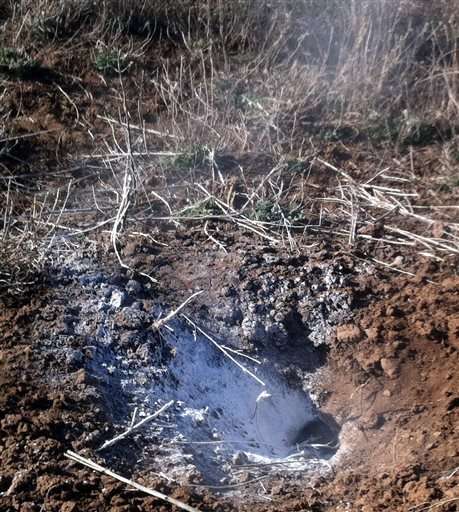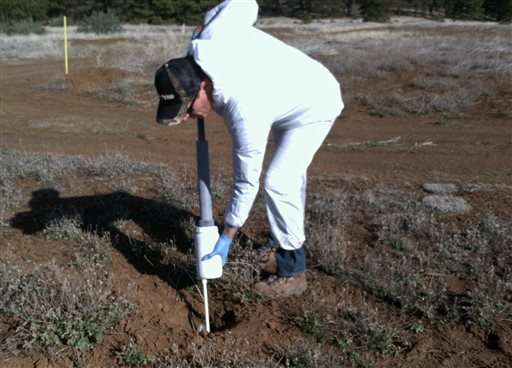This April 3, 2015, photo, provided by the Coconino County Public Health Services District shows pesticide dust coating a prairie dog burrow in the Picture Canyon Natural and Cultural Preserve in Flagstaff, Ariz. The pesticide dust was part of a treatment by workers for the Coconino County Public Health Services District after fleas there tested positive for plague. (Mare Schumacher/Coconino County Public Health Services District via AP)
Summertime in Arizona's higher terrain means an increased risk of residents and tourists coming into contact with rodents that carry the plague. Health officials spend the warmer months monitoring squirrels, mice and prairie dogs for the rare but sometimes fatal disease. They also warn the public to avoid contact with wildlife and recommend that pets have flea collars or be sprayed routinely.
Here are five things to know about plague in Arizona:
WHAT MAKES PLAGUE ENDEMIC IN PARTS OF ARIZONA?
Experts say plague has adapted to specific ecological conditions in most areas of Arizona above 4,500 feet in elevation. It's also endemic in parts of the western United States. The combination of the elevation and the temperature in areas like Flagstaff and the rim of the Grand Canyon allow fleas to transmit the bacteria to rodents, whereas the hotter temperatures in Phoenix or the floor of the Grand Canyon aren't suitable habitat for fleas.
___
HOW DO HEALTH OFFICIALS TRACK PLAGUE?
Coconino County health officials constantly look for massive die-offs in prairie dog colonies or other rodent populations that could indicate the presence of plague and rely heavily on the public for tips. The county will treat areas where animals could be infected. Earlier this year, the county dusted rodent burrows with insecticide at a popular hiking area in northeast Flagstaff after fleas tested positive for plague. At the Grand Canyon, health officials are trapping squirrels at the South Rim and combing the animals' fur for fleas that are tested for the plague. In 2014, 33 rodents were trapped and 267 fleas collected, all which tested negative for the plague, said Martin Stephens, the park's public health consultant. The monitoring will continue through September and beyond if needed.
___
HOW DO HUMANS CONTRACT PLAGUE?
Once known as the Black Death, plague is primarily a disease of animals but can be spread to humans through bites from infected fleas or contact with infected animals. Arizona has recorded 64 human cases of the plague since 1950, 10 of which were fatal. The most recent fatality was Eric York, a wildlife biologist who had performed a necropsy on a mountain lion in 2007 that died of the plague. A National Park Service review board found that he wasn't wearing gloves or a protective respirator.
In this April 3, 2015, photo, provided by the Coconino County Public Health Services District, Doug Murphy, an environmental specialist for the Coconino County Public Health Services District, treats prairie dog burrows with a dust pesticide in the Picture Canyon Natural and Cultural Preserve in Flagstaff, Ariz., after fleas there tested positive for plague. Health officials spend months monitoring squirrels, mice and prairie dogs for the rare but sometimes fatal disease. (Mare Schumacher/Coconino County Public Health Services District via AP)
___
WHAT ARE THE SYMPTOMS OF PLAGUE?
Symptoms that include fever, weakness, nausea and swelling of lymph glands generally appear between two and six days after humans are exposed to the plague. The disease can be cured with antibiotics if diagnosed and treated early. Health officials advise people to avoid contact with sick or dead animals, set up campsites away from rodent burrows and wear insect repellent to keep fleas away.
___
WHY MONITOR THE GRAND CANYON?
Millions of people visit the Grand Canyon each year, most of them sightseeing at the South Rim. The 2007 death of York sparked a lot of discussion about monitoring the national park for indications of the plague, said Randy Phillips of the Coconino County health office. Signs at the entrance to the two most popular trails, Bright Angel and South Kaibab, warn hikers not to feed the squirrels that can carry the plague. Health officials plan to trap squirrels and collect fleas at those trailheads, around the Maswik Lodge and El Tovar Hotel, and near the canyon overlooks of Mather Point and Yavapai Point, Stephens said. The squirrels are given an anesthetic that allows enough time to collect fleas, and the animals are released when they regain consciousness.
© 2015 The Associated Press. All rights reserved.





















